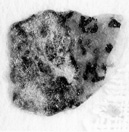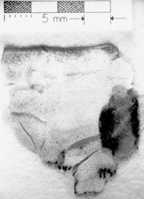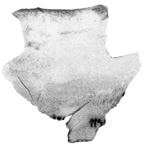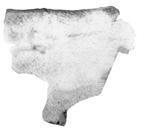Non-Roman fonts used: SPTiberian
Vol. 12, pp. 1-5
In early 1995 we received a request from Martin Sch°yen to do a new photographic analysis of small fragments mounted in a glass plate that he had recently purchased from John C. Trever, described in Trever's typed label as containing "Dead Sea Scroll Fragments from Qumran Cave I." Upon inquiry, Trever told us that these incidental pieces were given to him by Metropolitan Anthanasius Samuel in the late 1940’s in gratitude for the early photographic work he had done on the scrolls. The plate contains what might best be described as Dead Sea Scrolls scraps-bits of fabric, twine and skin that had broken off at one time or another from 1QIsaiah a, 1QSerekh, 1QGenesis Apocryphon and what Trever labeled as an "unidentified scroll."
None of the bits of skin, upon cursory inspection by eye, appeared likely to have any textual data on them; and indeed, Trever had assumed as much, since he described them in one of his original labels as "uninscribed fragments." Nonetheless, our past experiences documenting Dead Sea Scrolls have taught us that no fragment of skin should be so dismissed before it has been thoroughly examined. This is especially true now, since the new, narrow-band infrared techniques of documentation have amply demonstrated that often information can be recovered where previously it had been inaccessible. Therefore, in March, 1995, we made a new series of photographs of the Sch°yen fragments, utilizing visible light color, visible light black-and-white and infrared black-and-white films. While most of the fragments registered no evidence of textual data in our pictures, three small fragments showed traces of text, and two of the three fragments contained readable letters when photographed in narrow band infrared. These two fragments may be described as follows:
Sch°yen MS. 1926/4c
This fragment is 19 mm. by 18 mm. at its widest points. It is closely associated on the plate with a piece of woven cloth of the type that was used to wrap Dead Sea Scrolls for storage. On the back of the fragment one can see a layer of woven threads of this same type of cloth bonded to the surface, indicating that the two pieces probably come from the same source. The fragment's color is dark brown to black, and it has a number of thread-like light brown fibers randomly adhering to its surface on both sides. These appear to be unwound and frayed fibers from the cloth that the scroll was originally wrapped within. Even in our visible light pictures the fragment can be seen to be a complex assemblage consisting of a number of layers of skin now bonded together. This becomes even clearer when the visible light color and black and white infrared images are carefully compared. Altogether there appear to be indications of at least four layers of skin, which, from top to bottom, we may respectively label as one through four. No letters are visible on any layer of the fragment to the naked eye or in the pictures we took in visible light. However, in our infrared pictures, traces of letters from at least three lines are readable on the right side of the second surface layer and traces of other letters appear on layers three and four.

The layers are read as follows:
Layer one: no discernible data..
Layer two: traces of three lines reading as follows:
]. m K[ 1.
] )b/kl[ 2.
.]. .[ 3.
Layer three: one line with one clear letter, an `alep.
Layer four: two lines, each with the single letter lamed.
If this were all that could be determined about the fragment, it might not be worth publishing. Fortunately, however, the fragment can be identified with a particular Dead Sea Scroll manuscript, 1QDanielb, and the text on layer two can even be correctly placed relative to the previously known fragments of the document.
Determination of the identification was done first on the basis of the script. A key to this was the slightly idiosyncratic nature of the scribal hand. In particular the letters mem, `alep, and lamed display characteristics unusual in the scripts of Cave 1 manuscripts. The right vertical stroke of the mem is perpendicular to a completely horizontal base stroke so that the shape made by these two strokes and their connecting diagonal is basically a right equilateral triangle. The main diagonal of the `alep, rather than being straight or only very slightly curved as is usually the case, has a distinctive double curve like an elongated "s". Finally, the bulbous tip of the lamed in line two of layer two has to be assumed to have a very significant overhang to the left. Comparison with the script of 1QDanb shows letters similar in every case. In fact, when these various characteristics are considered together, this is the only Cave One scroll that immediately stands out as an obvious match.
A consideration of yet other factors made this probable identification certain. First of all the letter combination )kl[ looked to be an obvious Aramaic determined ending, just as one would expect for text from 1QDanb, which preserves portions of the Aramaic sections of Daniel from chapter three, and it was a fairly simple matter to check the fragment against the text of Daniel preserved in 1QDanb to determine whether there was a good potential join. It did not take us long to find a probable match in the partially preserved word at the end of line nine of fragment one of the manuscript, read in DJD I as ]lm and obviously to be restored in context as [)k]lm. A close analysis shows that the match is virtually certain. Not only are the lower portions of a lamed preserved in fragment one, line nine that seems a likely match to the bulbous tip of a lamed in the Sch°yen fragment, but the trace of the letter following the lamed on fragment one line nine of 1QDanb seems to fill out precisely the lower right corner of the kap, which is missing in the Sch°yen fragment. Furthermore the data in line one of the Sch°yen fragment also matches line eight of fragment one of 1QDanb. The partial final kap at the beginning of the Sch°yen line supplies the obvious ending to the reading ]rd# of fragment 1 line 8 and the letters following the final kap in the Sch°yen fragment are now best read as mem ligatured to yod followed by a shin, letter forms that are completely compatible with letters in the scribal hand of 1QDanb. The full reading is therefore to be rendered K#ym Krd#.
Finally, in order to confirm the match, we scanned a copy of Trever's original negative of 1QDanb shot in 1949 and our infrared pictures of the Sch°yen fragment shot in 1995. Using a standard computer imaging program we then scaled the two images so that they were the same size, cut the Sch°yen fragment out and moved it into the appropriate position next to fragment one of 1QDanb in order to make an electronic join (pl A). An enlargement of the fragments at the join shows a very clear match (see pl. B). Moreover, we then electronically filled in the missing gaps between letters utilizing "cloned" letters from elsewhere on the scroll as a guide. The full restoration can be seen in pl. C. Unfortunately, the new fragment does not allow for further linkage to fragment 2 of 1QDanb.
Finally, we made a thorough check of all the photographic data on the incidental fragments of 1QDanb and discovered among photographs taken by Trever in the late 1940s pictures that show both the front and back of the Sch°yen fragment Thus, not only have we reunited this fragment with its manuscript but we have been able to use modern infrared and electronic imaging techniques to read it and place it in its proper place in the manuscript for the first time.
Sch°yen MS. 1926/2c-e
These fragments are found in the middle of the bottom row of the plate and are labeled "Upper Edge of 1QApocGen." Like the Daniel fragment, they are a complex assemblage of several pieces now bonded together. The three clear fragments of the assemblage have been designated as fragments c, d and e according to the Sch°yen catalogue. Two additional fragments on the plate, labeled "Repair Material 1QApocGen," have been designated fragments a and b. Fragments a and b show no trace of letters in the infrared photographs and therefore will not be discussed any further.
Fragments c, d and e range in color from medium to dark brown. The entire assemblage measures at its widest points 29 mm. by 29 mm. and all three fragments are easily differentiable to the unaided eye.
When correctly oriented according to the clearest textual data, the assemblage has roughly the same shape as a pentagon standing on one of its points.

No letters had previously been noticed on these fragments before we began our photographic documentation, nor did we at first notice any textual data upon our inspection of the fragments by eye. Narrow band infrared photographs, however, show traces of letters on four areas of fragments c and d. We also realized in retrospect that these traces are discernible (although not clearly readable) in our visible light photographs (and even upon inspection by eye) once one knows where to look. In order to facilitate its description, we have electronically isolated fragment d and erased the data of the other fragments.

On the lower right edge of fragment d, going right-to-left, there appears to be a trace of an uncertain letter followed by what is probably a dalet or resh, and then a fairly certain he. There follows a space of about three to four letter widths. Then just at the border of a diagonal crack, traces of the tops of two to three more letters may be seen that are from the same line. At the very bottom of the fragment one can see traces of a second line that preserves the tops of a few letters. The last of these, just at the left edge of the fragment has a pronounced vertical extension and is therefore to be identified as a lamed. Above the first line is a considerable amount of blank space, indicating that this fragment is from the top of a column and has traces of its first two lines. The blank space in line one should not be interpreted as a column break for two reasons. First of all, judging from the clear column breaks of the manuscript, the space is too small. Moreover, when we direct our attention to the line immediately below, we can see that the text continues through the equivalent space. Of course, a break within a line is not without precedent in the Genesis Apocryphon. Note, for example, the breaks within lines found in col. 2 line 21 and col. 22, lines 20 and 32.
When we electronically isolate fragment c,

it shows traces of three letters, one of which is a lamed. No text appears in the upper part of fragment c, lending support to the probability that this fragment also comes from the top of a column of text.
Fragment e appears to show traces of two lines of text but the infrared images are far too blurred for reading and differentiation of individual letters. The only data of note are two pronounced spikes on one of the lines which are probably traces of lameds. We believe that the images are so poor because the fragment is flipped over and thus infrared images are being seen through the back of the scroll fragment. It may be possible at a future time to disengage fragment e from c, turn it over and then reapply narrow band infrared technology in order to gain more data from this fragment. But for now, its information—probably as much as 3-5 letters in each line—remains tantalizingly just out of reach.
We must further admit that, unlike the case above for 1QDanb, we cannot as yet make any dramatic joins to the Genesis Apocryphon with the new Sch°yen fragments. Nonetheless, these pieces merit careful consideration since they may ultimately aid us in the overall physical reconstruction of the early portions of the manuscript. At this point, we can make these preliminary observations.
A key clue in regard to the placement of fragments c and d comes from one of the earliest pictures ever taken of the Dead Sea Scrolls, the picture made by Trever in 1948 of the unrolled Genesis Apocryphon with several fragments broken off from it and mounted to the scroll's immediate right. All of these fragments were known and identified except for the fragment situated at the bottom right of the picture. Indeed, this small piece has, up until now been entirely ignored in all discussions of 1QapGen. However, when digitally reoriented clockwise about 45 degrees and compared to the Sch°yen fragments we have just been discussing, it becomes clear that this early picture depicts fragments c and d.
This early evidence is decisive in leading us to conclude that c and d must be closely associated with those fragments that were broken off at the same time, namely fragments in and around columns 1 and 2. Since fragments c and d are bonded together, it also seems likely that they are from successive layers of the scroll. As the circumference of the scroll is about 16–18 cm. and column width is approximately 12.5 cm., it also seems probable that the pieces come from successive columns with d being on the column preceding c. That means that we should place these fragments with either d on column zero and c on column one, d on column one and c on column two, or d on column two and c on column three, with the more outside columns being the most likely candidates for placement.
In order to pursue this line of reasoning we used computer imaging techniques to electronically "cut" fragments c and d apart and place the fragments with data from column zero, one and two in various configurations along the lines mentioned above. Fortunately there is fairly clear evidence for the tops of these columns in the Genesis Apocryphon. Especially fragment six of the 1Q20 fragments, which preserves the top of column zero and one, has clear rule lines that demarcate the end of the former and the beginning of the latter. Having disengaged the fragments, we have moved them around to see what approach looks best. Reasonably good physical fits can be made with fragments d and c and the early columns of the Genesis Apocryphon in at least two configurations-namely placing them respectively in column zero and one (see pl.D), or in columns one and two. However, we have not made any convincing letter joins that would allow us to suggest more certain placements.
Clearly this is still very much work-in-progress. For now, the best we can say is that, using new infrared and computer imaging techniques, we have been able to place at least two more small jigsaw pieces of the Genesis Apocryphon into play. While we cannot be certain how to employ them to best advantage right now, this may change in the future as we and others continue to seek to put the bits and pieces of this scroll back together.
* Originally delivered at the Annual Meeting of the Society of Biblical Literature, Aramaic Studies Section, November 1995.
For further information please contact Drs. Lundberg or Zuckerman at the West Semitic Research Project.
ę 1996 Comprehensive Aramaic Lexicon